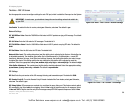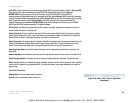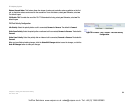
61
Chapter 6: Using the Web-based Utility
The Voice Tab
IP Telephony System
Dial Plan
Dial Plan. Enter the dial plan script for this line. Refer to “Appendix C: Dial Plan and Auto-Attendant Scripting for
Advanced Users” for more details.
Streaming Audio Server (SAS)
SAS Enable. To enable the use of the line as a streaming audio source, select yes. Otherwise, select no. If
enabled, the line cannot be used for outgoing calls. Instead, it auto-answers incoming calls and streams audio
RTP packets to the caller. The default is no.
SAS DLG Refresh Intvl. If this is not zero, it is the interval at which the streaming audio server sends out session
refresh (SIP re-INVITE) messages to determine if the connection to the caller is still active. If the caller does not
respond to the refresh message, then the System will end this call with a SIP BYE message. The range is 0 to
255 seconds (0 means that the session refresh is disabled).The default is 30.
SAS Inbound RTP Sink. This setting works around devices that do not play inbound RTP if the streaming audio
server line declares itself as a send-only device and tells the client not to stream out audio. Enter a Fully Qualified
Domain Name (FQDN) or IP address of an RTP sink; this will be used by the System’s streaming audio server line
in the SDP of its 200 response to an inbound INVITE message from a client.
Call Feature Settings
Blind Attn-Xfer Enable. This settings lets the System perform an attended transfer operation by ending the
current call leg and performing a blind transfer of the other call leg. If this feature is disabled, the System
performs an attended transfer operation by referring the other call leg to the current call leg while maintaining
both call legs. To use this feature, select yes. Otherwise, select no. The default is no.
MOH Server. Enter the user ID or URL of the auto-answering streaming audio server. When only a user ID is
specified, the current or outbound proxy will be contacted. Music-on-hold is disabled if the MOH Server is not
specified.
Xfer When Hangup Conf. This setting makes the System perform a transfer when a conference call has ended.
Select yes or no from the drop-down menu. The default is yes.
Conference Bridge URL. This feature supports external conference bridging for n-way conference calls (n > 2),
instead of mixing audio locally. To use this feature, set this parameter to that of the server's name, e.g.,
conf@myserver.com:12345 or conf (which uses the Proxy value as the domain).
Conference Bridge Ports. Select the maximum number of conference call participants. The range is 3 to 10. The
default is 3.
Figure 6-41: Voice - FXS 1 Screen - Call Feature Settings
Figure 6-39: Voice - FXS 1 Screen - Dial Plan
Figure 6-40: Voice - FXS 1 Screen - Streaming Audio
Server
VoIPon Solutions www.voipon.co.uk sales@voipon.co.uk Tel: +44 (0) 1245 600560


















